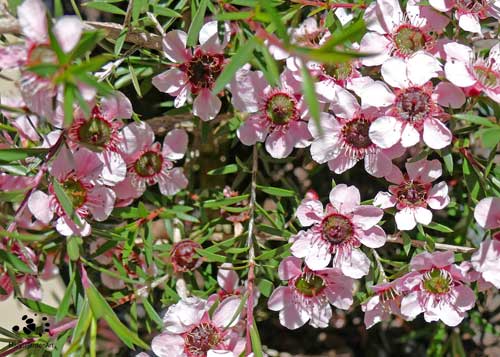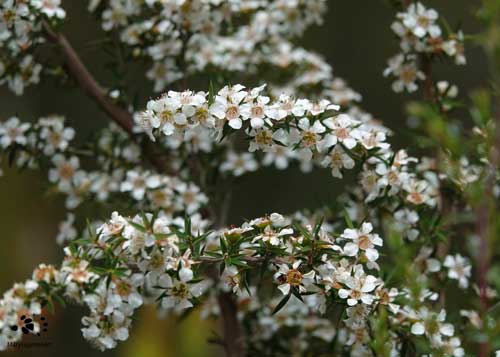Wildflower Photography with marysejansenart
Pretty Tea Trees flower abundantly but cause some confusion

Table of Contents
Tea Tree – Leptospermum
Tea Tree Flowers are very pretty. They have five petals which have a symmetrical rotate shape, which is so characteristic for the Tea Tree flowers. The stamen grow in a circle on the edge of the heart of the flower, in the centre of which grows the carpel – the female reproductive part. Depending on the species, the flowers can be up to 3cm in diameter. The colour of the flowers is usually white, but there are also pink and even red variations. The best part is the abundance with which the Tea Trees produce their flowers! The tree or shrub literally gets covered in these little beauties and flowering can last for a number of weeks, even two months!
Tea Trees belong to the genus Leptospermum and there are 81 species of native Leptospermum in Australia! The trees are evergreen and their leaves are small, thin and in some species aromatic when crushed. The name Tea Tree is derived from the fact that early settlers in Australia boiled the leaves of several Leptospermum species to make a tea.
Tea Trees can be found in a range of habitats. The various species will happily grow in mountain areas, wet coastal forests and woodlands as well as the arid inland. They are also very popular in the garden, for their compact growth, abundant flowering and work well for screening purposes.
The Prickly Tea Tree, which you can see in the image below, grows in heathland, woodland, on sandy soils and also in swampy places in south-east Australia. During my trip in South Australia in summer this species is in full bloom. It’s beautiful!

Manuka Honey
The sunny image that features this post shows a light pink variety of the species Leptospermum scoparium which is native to south-east Australia and New Zealand. Its size can range from a scrub to a moderately sized tree. Flowers are white or pink and cover the tree in spring and autumn. The tree is called Manuka Tea Tree in New Zealand.
You may have heard of Manuka honey, it is a well known bush-tucker for it’s medicinal properties. Manuka honey is produced by bees that only gather nectar from these specific trees. The honey is quite thick, dark in colour and has a rich flavour.
Manuka honey has some specific antibacterial qualities and it has been used traditionally for things like wounds and burns, oral health, sore throats, coughs and digestive issues. This is one of those products which usage has really taken off beyond Indigenous use as well. A medical-grade honey is produced which is used topically to treat wounds. Vocalists swear by Manuka honey to help recover quickly from throat infections, the common cold or vocal strain. They ingest it either directly from the spoon, or dissolved in warm water.
Tea Tree – Melaleuca alternifolia
So far, so good. But there is another well known product: Tea Tree oil. And now some confusion sets in about what is actually a Tea Tree because the Tea Tree Oil, does not come from a Leptospermum tree! Instead, it comes from a different genus, the Melaleuca. More specifically, we are talking here about the Melaleuca alternifolia, native to southeast Queensland and the northeast coast of New South Wales. This tree is also called the Tea Tree! Alternatively however, it is known as the Narrow-leafed Paper Bark.
This tree is called Tea Tree for an entirely different reason, which I also discussed in my post about Paperbark Trees: the trees leak tannins into the water of the swamps where they grow and these colour the water tea-brown! To be complete, Aboriginal People also use the leaves from the Narrow-leafed Paperbark Tree to create a medicinal tea.
Like the Leptospermum, these trees are also popular in the garden. They are small, evergreen trees. Their main feature of attraction is their beautiful papery bark. Their creamy-white bottle-brush type flowers attract many insects and birds from spring to early summer.
Tea Tree Oil
Tea Tree Oil is an essential oil, which is derived from the leaves of forementioned Tea Tree: the Melaleuca alternifolia. Traditionally, Aboriginal Peoples would extract the oil by crushing the leaves and inhaling it to help cure coughs and colds. They would also apply it to their skin to help heal things like small wounds and fungal infections. It is also a great insect repellent!
The oil has antibacterial, antiviral and antifungal properties. It is safe to use on the skin, but it’s best to dilute it to prevent skin irritation. Never ingest Tea Tree Oil though as it is toxic!
In my household we have experienced positive results while using (products with) this oil on itchy insect bites, as a deodorant and on minor cuts and bruises. It is also said to be great as a natural cleaning product, sanitizer and to help with a variety of skin conditions. Like the Manuka honey, Tea Tree Oil has become an established product in the modern society.
Myrtaceae
We can conclude that it looks like there are two native trees in Australia that legitimately are referred to as Tea Tree! It is a bit confusing, but at least they all belong to the same family: the Myrtaceae! Apart from Leptospermum and Melaleuca other well known genuses in this family are Eucalyptus, Callistemon (Bottle Brush) and Syzygium (Lily Pillies).
Join me on a lovely walk in the bush in South Australia where a Tea Tree of the Leptospermum genus features it’s abundant white flowers in the latest episode of ‘Come for a walk in the Australian Bush’ below:
If you are interested in purchasing a print of ‘Pink Abundance’ or would like to see what the image looks like on the various merchandise products, please head to my shop. For ‘Prickly Tea Tree, click here.


